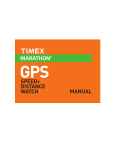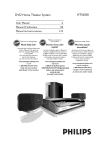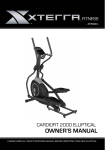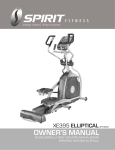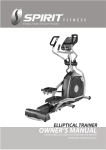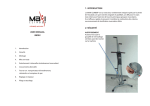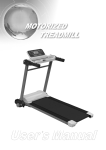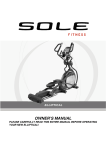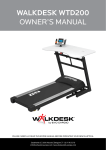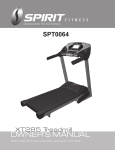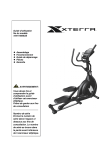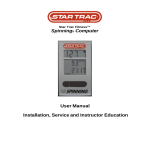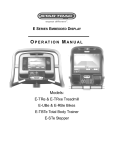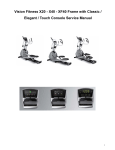Download user manual - Dyaco Sole
Transcript
OWNER’S MANUAL PLEASE CAREFULLY READ THIS ENTIRE MANUAL BEFORE OPERATING YOUR NEW ELLIPTICAL! 1 TABLE OF CONTENTS Important Safety Instructions 3 Important Electrical Information 4 Important Operation Instructions 5 Transport Instructions 5 Assembly Instructions 6 Elliptical Features 13 Operation of Your New Elliptical 14 Programmable Features 16 Using Heart Rate Monitor 22 General Maintenance 24 Exploded View Diagram 25 Parts List 26 ATTENTION THIS ELLIPTICAL IS INTENDED FOR RESIDENTIAL USE ONLY AND IS WARRANTED FOR THE APPLICATION. ANY OTHER APPLICATION VOIDS THIS WARRANTY IN ITS ENTIRETY. SE579SB-SE006_1404(SL)A 2 IMPORTANT SAFETY INSTRUCTIONS WARNING - Read all instructions before using this appliance. DANGER - To reduce the risk of electric shock disconnect your SOLE elliptical from the electrical outlet prior to cleaning and/or service work. WARNING - To reduce the risk of burns, fire, electric shock, or injury to persons, install the elliptical on a flat level surface with access to a 220-volt, 15-amp grounded outlet with only the elliptical plugged into the circuit. DO NOT USE AN EXTENSION CORD UNLESS IT IS A 14AWG OR BETTER, WITH ONLY ONE OUTLET ON THE END: DO NOT ATTEMPT TO DISABLE THE GROUNDED PLUG BY USING IMPROPER ADAPTERS, OR IN ANY WAY MODIFY THE CORD SET. A serious shock or fire hazard may result along with computer malfunctions. See Grounding Instructions, page 4. Do not operate elliptical on deeply padded, plush or shag carpet. Damage to both carpet and elliptical may result. Keep children away from the elliptical. There are obvious pinch points and other caution areas that can cause harm. Keep hands away from all moving parts. Never operate the elliptical if it has a damaged cord or plug. If the elliptical is not working properly, call your dealer. Keep the cord away from heated surfaces. Do not operate where aerosol spray products are being used or where oxygen is being administered. Sparks from the motor may ignite a highly gaseous environment. Never drop or insert any object into any openings. Do not use outdoors. To disconnect, turn all controls to the off position and then remove the plug from the outlet. Do not attempt to use your elliptical for any purpose other than for the purpose it is intended. The hand pulse sensors are not medical devices. Various factors, including the user’s movement, may affect the accuracy of heart rate readings. The pulse sensors are intended only as exercise aids in determining heart rate trends in general. Wear proper shoes. High heels, dress shoes, sandals or bare feet are not suitable for use on your elliptical. Quality athletic shoes are recommended to avoid leg fatigue. SAVE THESE INSTRUCTIONS - THINK SAFETY! 3 IMPORTANT ELECTRICAL INSTRUCTIONS WARNING! NEVER remove any cover without first disconnecting AC power. If voltage varies by ten percent (10%) or more, the performance of your elliptical may be affected. Such conditions are not covered under your warranty. If you suspect the voltage is low, contact your local power company or a licensed electrician for proper testing. NEVER expose this elliptical to rain or moisture. This product is NOT designed for use outdoors, near a pool or spa, or in any other high humidity environment. The operating temperature specification is 40 to 120 degrees Fahrenheit, and humidity is 95% non-condensing (no water drops forming on surfaces). GROUNDING INSTRUCTIONS This product must be grounded. If the elliptical should malfunction or breakdown, grounding provides a path of least resistance for electric current, reducing the risk of electric shock. This product is equipped with a cord having an equipment-grounding plug. The plug must be plugged into an appropriate outlet that is properly installed and grounded in accordance with all local codes and ordinances. DANGER - Improper connection of the equipment-grounding conductor can result in a risk of electric shock. Check with a qualified electrician or serviceman if you are in doubt as to whether the product is properly grounded. Do not modify the plug provided with the product if it will not fit the outlet; have a proper outlet installed by a qualified electrician. This product is for use on a nominal 220-volt circuit, and has a grounding plug that looks like the plug illustrated below. A temporary adapter that looks like the adapter illustrated below may be used to connect this plug to a 2-pole receptacle as shown below if a properly grounded outlet is not available. The temporary adapter should be used only until a properly grounded outlet, (shown below) can be installed by a qualified electrician. The green colored rigid ear-lug, or the like, extending from the adapter, must be connected to a permanent ground such as a properly grounded outlet box cover. Whenever the adapter is used, it must be held in place by a metal screw. 4 IMPORTANT OPERATION INSTRUCTIONS NEVER operate this elliptical without reading and completely understanding the results of any operational change you request from the computer. Understand that changes in resistance and incline do not occur immediately. Set your desired resistance level on the computer console and release the adjustment key. The computer will obey the command gradually. NEVER use your elliptical during an electrical storm. Surges may occur in your household power supply that could damage elliptical components. Unplug the elliptical during an electrical storm as a precaution. Use caution while participating in other activities while using your elliptical; such as watching television, reading, etc. These distractions may cause you to lose balance; which may result in serious injury. Always hold on to a handle bar while making control changes (incline, level, etc.). Do not use excessive pressure on console control keys. They are precision set to function properly with little finger pressure. If you feel the buttons are not functioning properly with normal pressure contact your SOLE dealer. POWER CONNECTOR - FRONT, LEFT SIDE OF UNIT TRANSPORT INSTRUCTIONS The elliptical is equippped with two transport wheels which are engaged when the rear of the elliptical is lifted. 5 ASSEMBLY PACK CHECKLIST 1 HARDWARE STEP 1 #142. Ø10 × Ø19 × 1.5T_ #157. Ø8 × 20 × 1.5T_ Flat Washer Flat Washer Flat Washer Flat Washer (2 pcs) (4 pcs) #155. Ø10 × 2T_ Spring Washer (1 pc) #158. Ø8 × 1.5T_Spring Washer (4 pcs) #117. M5 × P0.8 × 10L_ Phillips Head Screw (4 pcs) #151. Ø8 × 0.8T_Star Washer (4 pcs) #108. 5/16" × UNC18 × 2-1/4"_ Hex Head Bolt (4 pcs) #156. Ø10 × Ø23 × 2T_ Curved Washer (2 pcs) #134. 3/8" × UNC16 × 7T_Nyloc Nut (2 pcs) #106. 3/8" × UNC16 × 3/4"_Hex Head Bolt (2 pcs) #107. 3/8" × UNC16 × 1-1/2"_ Hex Head Bolt (2 pcs) #101. 3/8" × UNC16 × 2-1/4"_Hex Head Bolt (1 pc) 6 2 HARDWARE STEP 2 #100. 5/16" × UNC18 × 15L_ Hex Head Bolt (2 pcs) #126. Ø3.5 × 12L_ #145. Ø8 × Ø23 × 1.5T_ Sheet Metal Screw (6 pcs) Flat Washer (2 pcs) #153. Ø17 × 0.3T_ Wave Washer (4 pcs) 3 HARDWARE STEP 3 #109. 5/16" × UNC18 × 1-1/4"_Hex Head Bolt (2 pcs) 4 #185. Switch Wire Cap (2 pcs) #137. 5/16" × UNC18 × 7T_Nyloc Nut (2 pcs) #157. Ø8 × 20 × 1.5T_ Flat Washer (2 pcs) HARDWARE STEP 4 #115. M5 × P0.8 × 15L_ Phillips Head Screw (23 pcs) #125. M6 × P1.0 × 10L_ Phillips Head Screw (4 pcs) 7 #126. Ø3.5 × 12L_Sheet Metal Screw (4 pcs) ASSEMBLY TOOLS #160. Short Phillips Head Screwdriver #159. 13/14mm Wrench (160mm) #162. 12/14mm Wrench (160mm #161. Phillips Head Screwdriver ASSEMBLY INSTRUCTIONS PRE-ASSEMBLY 1. Using a razor knife (Box Cutter) cut the outside, bottom, edge of box along the dotted Line. Lift Box over the unit and unpack. 2. Carefully remove all parts from carton and inspect for any damage or missing parts. If damaged parts are found, or parts are missing, contact your dealer immediately. 3. for each step as needed to avoid confusion. The numbers in the instructions that are in parenthesis (#) are the item number from the assembly drawing for reference. 8 1 INCLINE BASE & MAST ASSEMBLY 2 HANDLE BAR ASSEMBLY See Page 9 for Illustration HARDWARE STEP 1 1. Connect the Rail Base Assembly (2) with the Rear Stabilizer of the Main Frame (1) using two Hex Head Bolts (107), two Flat Washers (142), two Nyloc Nuts (134) and four Hex Head Bolts (108) with four Flat Washers (157), four Spring Washers (158) and four Star Washer (151). Tighten with the wrenches pro- vided (159 & 162). 2. Connect the connecting wires for the incline motor (48 & 49), by matching the color codes of red, white and black. 3. Guide the Computer Cable (50) through the Console Mast Cover (72) and Console Mast (12), which also goes through Console Mast Cover (72). Pull the connector out of Console Mast (12) and insert into the U-Base on the main- frame and secure with the Hex Head Bolt (101) and Split Washer (155)that are on the U-Base and two Hex Head Bolts (106) and two Curved Washers (156). Use the Wrench (159) to secure the Console Mast (12) to the U-Base. Then slide the Console Mast Cover (72) down. 4. Plug in the Computer Cable (50), two Handpulse Cables (34 & 35), Upper Resistance Handle Cable (39), and Upper Incline Handle Cable (40) on the bottom of Console Assembly (45) and secure the Console Assembly (45) on the console holding plate with four Phillips Head Screws (117) by tightening them with Phillips Head Screw Driver (161). See Page10 for Illustration 1. Slide on two Wave Washers (153) and the corresponding Swing Arm (10-L) and (11-R) to each side of Console Mast shaft and secure with two Hex Head Bolts (100) and two Flat Washers (145) using the Wrench (162). 2. Connect the Upper Handle Resistance Cable (39) and Upper Handle Incline Cable (40) with the Lower Resistance/Incline Cables (198). Push the excessive wire into the Console Mast (12) and plug the Switch Wire Cap (185) into each side of the Console Mast (12). 3. Match the Front Handle Bar Cover (83-L) with Rear Handle Bar Cover (84-L) on the left Swing Arm (10) and secure with three Sheet Metal Screws (126) using the Phillips Head Screw Driver (161). Repeat on the Right Swing Arm (11) with the Front Handle Bar Cover (86-L), Rear Handle Bar Cover (85-R) and three Sheet Metal Screws (126). 9 #101. 3/8" × UNC16 × 2-1/4"_Hex Head Bolt (1 pcs) #106. 3/8" × UNC16 × 3/4"_Hex Head Bolt (2 pcs) #107. 3/8" × UNC16 × 1-1/2"_Hex Head Bolt (2 pcs) #108. 5/16" × UNC18 × 2-1/4"_Hex Head Bolt (4 pcs) #117 M5 × P0.8 × 10L_Phillips Head Screw (4 pcs) #134. 3/8" × UNC16 × 7T_Nyloc Nut (2 pcs) #142. Ø10 × Ø19 × 1.5T_Flat Washer (2 pcs) #151. Ø8 × 0.8T_Star Washer (4 pcs) #155. Ø10 × 2T_Spring Washer (1 pc) #156. Ø10 × Ø23 × 2T_Curved Washer (2 pcs) #157. Ø8 × Ø20 × 1.5T_Flat Washer (4 pcs) #158. Ø8 × 1.5T_Spring Washer (4 pcs) HARDWARE STEP 2 #100. 5/16" × UNC18 × 15L_Hex Head Bolt (2 pcs) #126. Ø3.5 × 12L_Sheet Metal Screw (6 pcs) #145. Ø8 × Ø23 × 1.5T_Flat Washer (2 pcs) #153. Ø17 × 0.3T_Wave Washer (4 pcs) #185. Switch Wire Cap (2 pcs) ASSEMBLY INSTRUCTIONS 1 ASSEMBLY STEP 1 2 ASSEMBLY STEP 2 10 3 4 CONNECTING ARM ASSEMBLY See Page 11 for Illustration 1. Untie the wire on the Rod End Bearing and connect the Left Swing Arm (10) with Left Connecting Arm (8) and secure with an Hex Head Bolt (109), Rod End Sleeve (19), Flat Washer (157) and Nyloc Nut (137) by using the Wrench- es provided (159 & 162). Repeat for Right Connecting Arm (9) and Right Swing Arm (11). HARDWARE STEP 3 #109. 5/16" × UNC18 × 1-1/4"_Hex Head Bolt (2 pcs) #137. 5/16" × UNC18 × 7T_Nyloc Nut (2 pcs) #157. Ø8 × Ø20 × 1.5T_Flat Washer (2 pcs) PLASTIC PARTS See Page 11 for Illustration Use either screw driver (160 or 161) to secure the following HARDWARE STEP 4 plastic parts. 1. Match the Connecting Arm Covers (88-R) with (87-L)on the #115. M5 × P0.8 × Left xConnecting Arm (8) and secure with two Phillips Head 15L_Phillips Head Screw Screws (115) and one Sheet Metal Screw (126). Repeat for (23 pcs) the Right Connecting Arm (9). #125. M6 × P1.0 × 10L_Phillips Head Screw 2. Install Slide Wheel Covers (82) above each slide wheel, and (4 pcs) secure with four Phillips Head Screws (115). #126. Ø3.5 × 12L_Sheet 3. Use two Phillips Head Screws (115) to secure the Middle Metal Screw (4 pcs) Stabilizer Covers (93-L & 94-R) to the middle stabilizer. 4. Use two Phillips Head Screws (115) to secure the Front Stabilizer Cover (79) on the front stabilizer. 5. Install the Cover Holders (21), with the hole facing backward, and secure them on the Rear Rail Assembly with four Phillips Head Screws (125). Then use two Phillips Head Screws (115) to secure Inclinable Rail Cover (91) on the rail base with Phillips Head Screw Driver (161). 6. Secure Rear Bar Cover (92) on the rear stabilizer and the Cover Holders (21) with four Phillips Head Screws (115). 7. Set the incline level between 3 and 8. Then install the Incline Bottom Cover (89) on the Rail Base Assembly (2) with two Phillips Head Screws (115). 8. Secure Front Console Cover (95) on the mast and then match with Rear Console Cover (96). Secure covers with three Phillips Head Screws (115) and two Sheet Metal Screws (126). 11 ASSEMBLY INSTRUCTIONS 3 ASSEMBLY STEP 3 4 ASSEMBLY STEP 4 12 ELLIPTICAL FEATURES INCLINE ADJUSTMENT The has an incline feature that will further increase the variety of your workouts. When the incline is at its lowest position you get a normal elliptical workout. As the incline increases you will feel your knees rise higher with each step; which means you are involving more muscle fibers, due to the increased range of motion. The has a computer controlled power incline. The power incline is controlled by buttons on the console and swing arms and will automatically adjust via the incline motor during the built-in workout program. 13 OPERATION OF YOUR ELLIPTICAL GETTING FAMILIAR WITH THE CONTROL PANEL CONSOLE COOLING FAN SPEAKER DATA WINDOWS (Pulse, Time, Distance, Calories) PROGRAM BUTTONS (Manual, Hill, Fat Burn, Strength, Interval, 2 User, 2HR) DOT MATRIX DISPLAY (Program Profiles) MESSAGE WINDOW (Program Name, RPM, Watts,Laps, & Incline) DISPLAY VIEW CONTROL KEYS FAN POWER SWITCH AUDIO IN JACK (MP3, CD, OR SMARTPHONE) HEADPHONE JACK POWER UP When power is connected to the elliptical the console will automatically power up. These models are connected directly to 230 VAC and there is a power switch located where the line cord plugs into the unit on the left side near the front (See page 4 for location). When it is first powered on, the console will perform an internal self-test. During this time all the lights will turn on, the Message Window display will show a software version (i.e.: VER 1.0), and the Distance Window will display an odometer reading. The odometer shows how many virtual kilometer the elliptical has gone. The Time Window shows how many total hours the elliptical has been used. The odometer and time will remain displayed for only a few seconds then the console will go to the startup display. The dot matrix display will be scrolling through the different workout profiles and the Message Window will be scrolling the start up message. You may now begin to use the console. 14 CONSOLE OPERATION QUICK START This is the quickest way to start a workout. After the console powers up you just press the Start key to begin, this will initiate the Quick Start mode. In Quick Start, the time will count up from zero. The resistance level and incline can be adjusted manually by pressing the Incline or Level / buttons. The dot matrix display will be showing a track with a blinking dot indicating your progress as it travels around the track. ▲▼ BASIC INFORMATION The Message Window will initially display Laps completed. Each time the Display button is pressed the next set of information will appear. The order of information displayed will be: Speed (in KPH), RPM (Revolutions per minute), Level, Watts, Segment Time and Data Scan mode. In Data Scan mode, the displayed information will change every 4 seconds in the Message Window. The Elliptical has a built in heart rate monitoring system. Simply grasping the Contact Heart Rate Sensors on the stationary handle bars or wearing the chest strap transmitter will start the heart (see Heart Rate Programs) Icon blinking (this may take a few seconds). The Pulse Window will display your heart rate in beats per minute and the HR bar graph will show your current % in relation to projected heart rate maximum. The chest strap is a more accurate and reliable method of heart rate reading. The hand pulse sensors are subject to false readings depending on user physiology and workout habits including how one grips the sensors or how sweaty their hands are. The Stop button actually has several functions. Pressing the Stop key once during a program will Pause the program for 5 minutes. If you need to get a drink, answer the phone or any of the many things that could interrupt your workout, this is a great feature. To resume your orkout during Pause just press the Start key. If the Stop button is pressed twice during a workout the program will end and a Workout Summary is displayed. If the Stop key is held down for 3 seconds the console will perform a complete Reset. During data entry for a program the Stop key performs a Previous Screen function. This allows you to go back one step in the programming each time you press the Stop key. There is an Audio In Jack ( ) on the front of the console and built-in speakers. You may plug any low-level audio source signal into this port. Audio sources include MP3, iPod, portable radio, CD player or even a TV or computer audio signal. There is also a Headphone Jack ( )for private listening. PROGRAMMING THE CONSOLE Each of the programs can be customized with your personal information and changed to suit your needs. Some of the information asked for is necessary to ensure the readouts are correct. You will be asked for your Age and Weight. Entering your Age is necessary during the Heart Rate control program to ensure the correct settings are entered in the program; entering your Weight aides in calculating a more correct Calorie reading. Although we cannot provide an exact calorie count we do want to be as close as possible. 15 A message about Calories: Calorie readings on every piece of exercise equipment, whether it is in a gym or at home, are not accurate and tend to vary widely. They are meant only as a guide to monitor your progress from workout to workout. The only way to measure your calorie burn accurately as in a clinical setting connected to a host of machines. This is because every person is different and burns calories at a different rate. ENTERING A PROGRAM AND CHANGING SETTINGS Press each program button to scroll through the program selections. The profile for each program will be displayed in the dot matrix window. Both models will show the incline profile also when the Display key is pressed. Press the Enter key to select a program and begin customizing the settings. If you want to workout without entering new settings, then just press the Start key. This will bypass the programming of data and take you directly to the start of your workout. If you want to change the personal settings, then just follow the instructions in the Message Window. If you start a program without changing the settings, the default settings will be used. Note: Age and Weight default settings will change when you enter a new number. So the last Age and Weight entered will be saved as the new default settings. If you enter Age and Weight the first time you use the elliptical you will not have to enter it every time you work out unless either Age or Weight has changed or someone else entersa different Age and Weight. PROGRAMMABLE FEATURES MANUAL PROGRAM The Manual program works as the name implies, manually. This means that you control the workload yourself and not the computer. 1. Press the Manual program button then press the Enter key. 2. The Message Window will ask you to enter your Age. You may adjust the age setting using the Incline or Level / keys, then press the Enter key to accept the new number and proceed on to the next screen. 3. You are now asked to enter your Weight. You may adjust your weight setting using the Incline or Level / keys, then press Enter to continue. 4. Next is the Time. You may adjust the length of Time by pressing the Incline or Level / keys, then press Enter to continue. 5. Now you are finished editing the settings and can begin your workout by pressing the Start key. You can also go back and modify your settings by pressing the Stop key to go back one level of the programming screen. 6. Once the program starts the elliptical will be set to level one. This is the easiest level and it is a good idea to stay at level one for a while to warm up. If you want to increase the work load at any time press the Level key; the Level key will decrease the workload. 7. During the Manual program you will be able to scroll through the data in the Message Window by pressing the Display key. 8. When the program ends the Message Window will show a summary of your workout. The summary will be displayed for a short time then the console will return to the startup display. ▲▼ ▲▼ ▲▼ ▲ ▼ 16 PRESET PROGRAMS The Elliptical has five different programs that have been designed for a variety of workouts. These five programs have factory preset work level profiles for achieving different goals. Hill The Hill program simulates going up and down a hill. The resistance in the pedals will steadily increase and then decrease during the program. WORK INCLINE Fat Burn The Fat Burn program is designed, as the name implies, to maximize the burning of fat. There are many schools of thought on the best way to burn fat but most experts agree that a lower exertion level that stays at a steady workload is the best. The absolute best way to burn fat is to keep your heart rate at around 60% to 70% of its maximum potential. This program does not use heart rate but simulates a lower, steady exertion workout. WORK INCLINE Cardio The Cardio program is designed to increase your cardiovascular function and endurance. This is exercise for your heart and lungs. It will build up your heart muscle and increase blood flow and lung capacity. This is achieved by incorporating a higher level of exertion with slight fluctuations in work. WORK INCLINE Strength The Strength program is designed to increase muscular strength in your lower body. This program will steadily increase in resistance to a high level and forces you to sustain it. This is designed to strengthen and tone your legs and glutes (muscles of the butt). WORK INCLINE Interval The Interval program takes you through high levels of intensity followed by periods of low intensity. This program increases your endurance by depleting your oxygen level followed by periods of recovery to replenish oxygen. Your cardiovascular system gets programmed to use oxygen more efficiently this way. This program also forces your body to become more efficient due to spikes in heart rate, between recovery periods. This aids in heart rate recovery from intense activities. WORK INCLINE 17 PROGRAMMING PRESET BUTTONS 1. Press the desired program button then press the Enter key. 2. The Message Window will ask you to enter your Age. You may adjust the age setting, using the Incline or Level / keys, then press the Enter key to accept the new number and proceed on to the next screen. 3. You are now asked to enter your Weight. You may adjust the weight number using the Incline or Level / keys then press Enter to continue. 4. Next is Time. You may adjust the Time and press Enter to continue. 5. Now you are asked to adjust the Max Level. This is the peak exertion level you will experience during the program (the highest colored segment/box of the program profile). Adjust the level and then press Enter. 6. You can now choose to turn on the incline profile for this program. If you choose to turn off incline, you can still control the incline manually during your workout, but the automated incline changes will be off. Press the Enter key when you are finished selecting. 7. Now you are finished editing the settings and can begin your workout by pressing the Start key. You can also go back and modify your settings by pressing the Stop key to go back one level, or screen. 8. If you want to increase or decrease the resistance or incline at any time during the program press the Incline or Level / keys. 9. During the program you will be able to scroll through the data in the Message Window by pressing the Display key. 10. When the program ends the Message Window will show a summary of your workout. The summary will be displayed for a short time then the console will return to the start-up display. ▲▼ ▲▼ ▲▼ CUSTOM USER DEFINED PROGRAMS The customizable User programs allow you to build and save your own workout. You can build your own custom program by following the instructions below. 1. Select the User program (U1 or U2) then press Enter. If you have already saved a program to either U1 or U2, it will be displayed and you are ready to begin. If not, you will have the option of inputing a username. In the Message Window, the letter “A” will be blinking. Use the / Incline or Level buttons to select the appropriate first letter of your name (pressing the Level / button will switch to the letter “B”; pressing the Down button will switch to letter “Z”). Press Enter when the desired letter is displayed. Repeat this process until all of the characters of your name have been programmed (maximum 7 characters). When finished press Stop. 2. If there is a program already stored in User when you press the key, you will have an option to run the program as it is or delete the program and build a new one. At the welcome message screen, when pressing Start or Enter you will be prompted: Run Program? Use the Level / to select Yes or No. If you select No, you will then be asked if you want to delete the currently saved program. It is necessary to delete the current program if you want to build a new one. 3. The Message Window will ask you to enter your Age. You may enter your age using the Incline or Level / keys, then press the Enter key to accept the new number and proceed on to the next screen. 4. You are now asked to enter your Weight. You may adjust the weight number using the Incline or Level / keys, then press Enter to continue. 5. Next is Time. You may adjust the Time using the Incline or Level / keys and press Enter to continue. 6. Now the first column will be blinking and you are asked to adjust the level for the first segment of the workout. When you finish adjusting the first segment, or if you don’t want ▲▼ ▲▼ ▲▼ ▲▼ ▲▼ ▲▼ 18 to change, then press Enter to continue to the next segment. The next segment will show the same level as the previously adjusted segment. Repeat the same process as the last segment then press Enter. Continue this process until all twenty segments have been set. 7. Now the first column will be blinking again and you are asked to adjust the Incline level for the first segment of the workout. Follow the same procedure for building the Incline profile as you did for the resistance profile. 8. The Message Window will then tell you to start to begin (and save the program) or Enter to modify the program. Pressing Stop will exit to the start up screen. 9. If you want to increase or decrease the workload at any time during the program press the Incline or Level / key. This will only affect the Incline or Level for the present column in the profile. When the profile changes to the next column it will return to the preset work level. 10. During the User 1 or User 2 program you will be able to scroll through the data in the Message Window by pressing the Display key. 11. When the program ends the Message Window will show a summary of your workout. The summary will be displayed for a short time then the console will return to the start-up display. ▲▼ 19 HEART RATE PROGRAMS Before we get started, a word about Heart Rate: The old motto, “no pain, no gain”, is a myth that has been overpowered by the benefits of exercising comfortably. A great deal of this success has been promoted by the use of heart rate monitors. With the proper use of a heart rate monitor, many people find that their usual choice of exercise intensity was either too high or too low and exercise is much more enjoyable by maintaining their heart rate in the desired benefit range. To determine the benefit range in which you wish to train, you must first determine your Maximum Heart Rate. This can be accomplished by using the following formula: 220 minus your age. This will give you the Maximum Heart Rate (MHR)for someone of your age. To determine the effective heart rate range for specific goals you simply calculate a percentage your MHR. Your Heart rate training zone is 50% to 90% of your maximum heart rate. 60% of your MHR is the zone that burns fat while 80% is for strengthening the cardio vascular system. This 60% to 80% is the zone to stay in for maximum benefit. For someone who is 40 years old their target heart rate zone is calculated: 220 – 40 = 180 (maximum heart rate) 180 x .6 = 108 beats per minute (60% of maximum) 180 X .8 = 144 beats per minute (80% of maximum) So for a 40 year old the training zone would be 108 to 144 beats per minute. If you enter your age during programming the console will perform this calculation automatically. Entering your age is used for the Heart Rate programs. After calculating your MHR you can decide upon which goal you would like to pursue. The two most popular reasons for, or goals, of exercise are cardiovascular fitness (training for the heart and lungs) and weight control. The black columns on the chart above represent the MHR for a person whose age is listed at the bottom of each column. The training heart rate, for either cardiovascular fitness or weight loss, is represented by two different lines that cut diagonally through the chart. A definition of the lines’ goal is in the bottom left-hand corner of the chart. If your goal is cardiovascular fitness or if it is weight loss, it can be achieved by training at 80% or 60%, respectively, of your MHR on a schedule approved by your physician. Consult your physician before participating in any exercise program. 20 RATE OF PERCEIVED EXERTION Heart rate is important but listening to your body also has a lot of advantages. There are more variables involved in how hard you should workout than just heart rate. Your stress level, physical health, emotional health, temperature, humidity, the time of day, the last time you ate and what you ate, all contribute to the intensity at which you should workout. If you listen to your body, it will tell you all of these things. The rate of perceived exertion (RPE), also know as the Borg scale, was developed by Swedish physiologist G.A.V. Borg. This scale rates exercise intensity from 6 to 20 depending upon how you feel or the perception of your effort. The scale is as follows: Rating Perception of Effort 6 Minimal 7 Very, very light 8 Very, very light + 9 Very light 10 Very light + 11 Fairly light 12 Comfortable 13 Somewhat hard 14 Somewhat hard + 15 Hard 16 Hard + 17 Very hard 18 Very hard + 19 Very, very hard 20 Maximal You can get an approximate heart rate level for each rating by simply adding a zero to each rating. For example a rating of 12 will result in an approximate heart rate of 120 beats per minute. Your RPE will vary depending up the factors discussed earlier. That is the major benefit of this type of training. If your body is strong and rested, you will feel strong and your pace will feel easier. When your body is in this condition, you are able to train harder and the RPE will support this. If you are feeling tired and sluggish, it is because your body needs a break. In this condition, your pace will feel harder. Again, this will show up in your RPE and you will train at the proper level for that day. 21 USING HEART RATE TRANSMITTER (Optional) How to wear your wireless chest strap transmitter: 1. 2. 3. 4. 5. 6. Attach the transmitter to the elastic strap using the locking parts. Adjust the strap as tightly as possible as long as the strap is not too tight to remain comfortable. Position the transmitter with the centered in the middle of your body facing away from your chest (some people must position the transmitter slightly left of center). Attach the final end of the elastic strap by inserting the round end and, using the locking parts, secure the transmitter and strap around your chest. Position the transmitter immediately below the pectoral muscles. Sweat is the best conductor to measure very minute heart beat electrical signals. However, plain water can also be used to pre-wet the electrodes (2 ribbed oval areas on the reverse side of the belt and both sides of the transmitter). It’s also recommended that you wear the transmitter strap a few minutes before your work out. Some users, because of body chemistry, have a more difficult time in achieving a strong, steady signal at the beginning. After “warming up”, this problem lessens. As noted, wearing clothing over the transmitter/strap doesn’t affect performance. Your workout must be within range - distance between transmitter/receiver – to achieve a strong steady signal. The length of range may vary somewhat but generally stay close enough to the console to maintain good, strong, reliable readings. Wearing the transmitter immediately against bare skin assures you of proper operation. If you wish, you may wear the transmitter over a shirt. To do so, moisten the areas of the shirt that the electrodes will rest upon. Note: The transmitter is automatically activated when it detects activity from the user’s heart. Additionally, it automatically deactivates when it does not receive any activity. Although the transmitter is water resistant, moisture can have the effect of creating false signals, so you should take precautions to completely dry the transmitter after use to prolong battery life (estimated transmitter battery life is 2500 hours). The replacement battery is Panasonic CR2032. ERRATIC OPERATION Caution! Do not use this treadmill for Heart Rate unless a steady, solid Actual Heart Rate value is being displayed. High, wild, random numbers being displayed indicate a problem. Areas to look for interference which may cause erratic heart rate: 1. 2. 3. 4. 5. Microwave ovens, TV’s, small appliances, etc. Fluorescent lights. Some household security systems. Perimeter fence for a pet. Some people have problems with the transmitter picking up a signal from their skin. If you have problems try wearing the transmitter upside down. Normally the transmitter will be oriented so the is right side up. 6. The antenna that picks up your heart rate is very sensitive. If there is an outside noise source, turning the whole machine 90 degrees may de-tune the interference. 7. Loose treadmill console or bolts in the upright tube. 8. Another Individual wearing a transmitter within 3’ of your machine’s console. If you continue to experience problems contact your dealer. WARNING! - DO NOT USE THE HEART RATE PROGRAM IF YOUR HEART RATE IS NOT REGISTERING PROPERLY ON THE TREADMILL’S DISPLAY! 22 HEART RATE PROGRAM OPERATION Both programs operate the same, the only difference is that the default for HR1 is set to 60% and HR2 is set to 80% of the maximum heart rate. They both are programmed the same way. To start an HR program follow the instructions below or just select the HR1 or HR2 program, then press the Enter button and follow the directions in the Message Window. 1. Press the HR1 or HR2 key, then press the Enter key. 2. The Message Window will ask you to enter your Age. You may enter your Age, using the Level / keys or the numeric key pad, then press the Enter key to accept the new number and proceed on to the next screen. 3. You are now asked to enter your Weight. You may adjust the Weight number using the Level / keys or the numeric key pad, then press Enter to continue. 4. Next is Time. You may adjust the Time and press Enter to continue. 5. Now you are asked to adjust your Target Heart Rate. This is the heart rate level you will strive to reach and maintain during the program. Adjust the level and then press Enter. 6. Now you are finished editing the settings and can begin your workout by pressing the Start key. You can also go back and modify your settings by pressing the Enter key. ▲▼ ▲▼ Note: At any time during the editing of Data you can press the Stop key to go back one level, or screen. 7. If you want to increase or decrease the workload at any time during the program press the Level / keys. This will allow you to change your Target Heart Rate at any time during the program. 8. During the HR1 or HR2 programs you will be able to scroll through the data in the Message Window by pressing the adjacent Display key. 9. When the program ends you may press Start to begin the same program again or Stop to exit the program. ▲▼ 23 GENERAL MAINTENANCE 1. Wipe down all areas in the sweat path with a damp cloth after each workout. 2. If a squeak, thump, clicking or rough feeling develops the main cause is most likely one of two reasons: I. The hardware was not sufficiently tightened during assembly. All bolts that were installed during assembly need to be tightened as much as possible. It may be necessary to use a larger wrench than the one provided if you cannot tighten the bolts sufficiently. I cannot stress this point enough; 90% of calls to the service department for noise issues can be traced to loose hardware or the rear rails being dirty. II. Dirt build-up on the rear rails and polyurethane wheels are also a source of noise.Noise from build-up on the rails can cause a thumping sound that you would swear is coming from inside the main body of the machine because noise travels, and is amplified in the tubing of the frame. Clean the rails and wheels with a lint free cloth and rubbing alcohol. Stubborn build-up can be removed with your thumbnail or a non-metallic scraper, like the back edge of a plastic knife. After cleaning, apply a small amount of lubricant on the rails with your fingers or a lint free cloth. You only need a thin coat of lubrication, wipe off any excess. 3. If squeaks or other noises persist, check that the unit is properly leveled before calling the service department. MAINTENANCE MENU IN CONSOLE SOFTWARE The console has built in maintenance/diagnostic software. The software will allow you to change the console settings from English to Metric and turn off the beeping of the speaker when a key is pressed for example. To enter the Maintenance Menu (may be called Engineering Mode, depending on version) press and hold down the Start, Stop and Enter keys keep holding the keys down for about 5 seconds and the Message Window will display “Engineering Mode”. Press the Enter button to access the menu below. Press the Level / keys to navigate the menu. ▲▼ A. Key Test - Will allow you to test all the keys to make sure they are functioning B. Display Test - Automatically tests all LCD’s C. Functions - Press Enter to access settings, use Level / keys to scroll I. ODO Reset - Resets the odometer II. Units - Choose from English or Metric display readings III. Display Mode - Turn off to have the console power down automatically after 30 minutes of inactivity IV. Motor Test - Continually runs the tensioning gear motor V. Manual - Allows stepping of the gear motor VI. Pause Mode - Turn on to allow 5 minutes of pause, turn off to have console pause indefinitely VII. Key Tone - Turn on or off the beep sound when a key is pressed D. Security - Allows you to lock the keypad so no unauthorized use of the machine is allowed. When the child lock is enabled, the console will not allow the keypad to operate unless you press and hold the Start and Enter buttons for 3 seconds to unlock the console. E. Factory Set F. Exit - Select to exit Maintenance Menu ▲▼ Incline Calibration: If there is a problem with the incline, try running the calibration. Press the Incline up key and the Start key at the same time. Hold them down for 5 seconds and the Incline calibration will start and run automatically. If the problem persists contact service department. 24 EXPLODED VIEW DIAGRAM 25 PARTS LIST Part Number 1 2 3 4 5 6 7 8 9 10 11 12 13 14 15 16 17 18 19 20 21 22 23 24 25 26 27 28 29 30 31 32 33 34 35 36 37 38 39 40 41 42 43 44 Part Description Main Frame Rail Base Assembly Console Holder Assembly Cross Bar Bushing Housing, Pedal Arm Pedal Arm (L) Pedal Arm (R) Connecting Arm (L) Connecting Arm (R) Swing Arm (L) Swing Arm (R) Console Mast Idler Wheel Assembly Crank Axle Adjustable Pedal Pedal Adjustment Assembly Rear Rail Assembly Locking Tube Assembly Ø11.9 × Ø8.5 × 15m/m_Rod End Sleeve Axle for Pedal Cover Holder(B) Control Fixing Plate 2.0T × 625m/m_Aluminum Rail 6005_Bearing 6003_Bearing 6203_Bearing M12 × P1.75_Rod End Bearing Drive Belt Flywheel Magnet Ø1-1/4" × 3T × 420m/m_Handgrip Foam Steel Cable 790m/m_Incline Motor 850m/m_Handpulse W/Cable Assembly (White) 850m/m_Handpulse W/Cable Assembly (Red) Handgrip Resistance Label (INCLINE) Handgrip Resistance Label (LEVEL) Resistance Button W/Cable 450m/m_Handle Wire (Upper), Resistance 450m/m_Handle Wire (Upper), Incline Power Cord Incline Controller Incline Adaptor 400m/m_Audio Cable 26 Qty per unit 1 1 1 2 2 1 1 1 1 1 1 1 1 1 2 2 1 1 3 2 2 1 4 2 16 2 2 1 1 1 2 1 1 1 1 1 1 2 1 1 1 1 1 1 Part Number 45 45~1 45~2 45~3 45~4 45~5 45~6 45~7 45~8 45~9 45~10 45~11 45~12 45~13 45~14 45~15 45~16 45~17 45~18 45~19 45~20 45~21 45~22 45~23 45~24 45~25 45~26 45~27 45~28 45~29 46 47 48 49 50 51 52 53 54 55 56 57 58 59 60 61 62 Part Description Console Assembly Console Top Cover Console Bottom Cover Fan Fixing Plate Deflector Fan Grill Speaker Grill Anchor Fan Grill Anchor 400m/m_Fan Assembly(White) 300m/m_W/Receiver, HR Interface Board Console Display Board Main Key Board 250m/m_Speaker W/Cable Amplifier Controller 300m/m_Sound Board W/Cable (White) LCD Transparent Piece 300m/m_Earphone Socket 250m/m_Amplifier Cable Speaker Iron Net (L) Speaker Iron Net (R) 9" Water-resist Rubber 6key Resistance Button W/Cable Key Fast Board (L) Book Rack Key Fast Board Foam Key Fast Board (R) Key Foam Key Board Cover LOGO Chain Cover Speaker Grill Anchor(Ø12×5.5T) 300m/m_Connecting Wire, Controller(Red) 850m/m_Computer Cable 900m/m_Connecing Wire, Incline Motor Power Cord 850m/m_Connecting Wire, Incline Motor 1550m/m_Computer Cable AC Electronic Module 80m/m_Connecting Wire (White) 200m/m_Ground Wire Gear Motor(317-020001) 400m/m_Sensor W/Cable Ø62_Transportation Wheel Ø78_Slide Wheel , Urethane Ø35 × 10m/m_Rubber Foot WFM-2528-21_Bushing Ø330_Drive Pulley Ø32(1.8T)_Button Head Plug 32 × 2.5T_Round Cap 27 Qty per unit 1 1 1 1 1 6 4 1 1 1 1 1 2 1 1 1 1 1 1 1 1 2 1 1 2 1 1 1 1 6 2 1 1 1 1 1 2 1 1 1 2 4 4 4 1 4 6 Part Number 63 64 65 67 68 69 70 71 72 73 74 75 76 77 78 79 80 81 82 83 84 85 86 87 88 89 90 91 92 93 94 95 96 97 98 100 101 102 103 104 105 106 107 108 109 110 111 Part Description Ø25.5 × 33.5 × 1.5T_Nylon Wave Washer Ø26.5 × 6 × 10T_Rubber Foot Pad Ø25 × Ø25 × 15T_Rubber Foot Pad 3/8" × 35 × 5T_Nylon Washer Ø30 × 19m/m_Upright Bushing Ø38 × Ø34 × Ø26 × 4 + 16T_Bushing Handle Switch Bracket Spacer Bushing Console Mast Cover Side Case (L) Side Case (R) Round Disk Round Disk Cover Pedal Arm Cover (L) Pedal Arm Cover (R) Front Stabilizer Cover Pedal (L) Pedal (R) Slide Wheel Cover Front Handle Bar Cover (L) Rear Handle Bar Cover (L) Front Handle Bar Cover (R) Rear Handle Bar Cover (R) Connecting Arm Cover (L) Connecting Arm Cover (R) Incline Bottom Cover Incline Cover Inclinable Rail Cover Rear Bar Cover Middle Stabilizer Cover (L) Middle Stabilizer Cover (R) Console Chin Cover (Front) Console Chin Cover (Rear) 5/16" × 25 × 3T_Nylon Washer Sensor Rack 5/16" × UNC18 × 15L_Hex Head Bolt 3/8" × UNC16 × 2-1/4"_Hex Head Bolt 5/16" × UNC18 × 25L_Hex Head Bolt 1/4" × UNC20 × 3/4"_Hex Head Bolt 3/8" × UNC16 × 2-1/2''_Hex Head Bolt 3/8" × UNC16 × 1-1/2"_Hex Head Bolt 3/8" × UNC16 × 3/4"_Hex Head Bolt 3/8" × UNC16 × 1-1/2"_Hex Head Bolt 5/16" × UNC18 × 2-1/4"_Hex Head Bolt 5/16" × UNC18 × 1-1/4"_Hex Head Bolt 3/8" × UNC16 × 2-1/4"_Socket Head Cap Bolt M8 × P1.25 × 40L_Socket Head Cap Bolt 28 Qty per unit 2 2 4 2 2 2 2 1 1 1 1 2 2 1 1 1 1 1 2 1 1 1 1 2 2 1 1 1 1 1 1 1 1 2 1 10 2 2 4 2 1 2 2 4 2 2 2 Part Number 114 115 116 117 120 121 122 123 124 125 126 130 131 133 134 136 137 138 139 140 142 144 145 147 148 150 151 152 153 154 155 156 157 158 159 160 161 162 163 165 166 167 169 171 172 173 174 Part Description 5/16" × UNC18 × 2"_Button Head Socket Bolt M5 × P0.8 × 15L_Phillips Head Screw M5 × P0.8 × 10L_Phillips Head Screw M5 × P0.8 × 10L_ Phillips Head Screw Ø5 × 16L_Tapping Screw Ø5 × 19L_Tapping Screw Ø5 × 16L_Tapping Screw Ø3.5 × 16L_Sheet Metal Screw Ø3 × 20L_Tapping Screw M6 × P1.0 × 10L_Phillips Head Screw Ø3.5 × 12L_Sheet Metal Screw Ø25_C Ring Ø17_C Ring M8 × P1.25 × 7T_Nyloc Nut 3/8" × UNC16 × 7T_Nyloc Nut 1/4" × UNC20 × 8T_Nyloc Nut 5/16" × UNC18 × 7T_Nyloc Nut 3/8" × UNF26 × 4T_Nut 3/8" × UNF26 × 11T_Nut 3/8" × UNC16 × 7T_Nut Ø10 × Ø19 × 1.5T_Flat Washer Ø8 × Ø35 × 1.5T_Flat Washer Ø8 × Ø23 × 1.5T_Flat Washer Ø6.5 × Ø19 × 1T_Flat Washer Ø17 × Ø23.5 × 1T_Flat Washer Ø8 × Ø35 × 2.0T_Flat Washer Ø8 × 0.8T_Star Washer M8 × P1.25 × 170L_J Bolt Ø17 × 0.3T_Wave Washer M8 × P1.25 × 20L_Carriage Bolt Ø10 × 2T_Spring Washer Ø10 × Ø23 × 2T_Curved Washer Ø8 × 20 × 1.5T_Flat Washer Ø8 × 1.5T_Spring Washer 13/14m/m_Wrench Short Phillips Head Screw Driver Phillips Head Screw Driver 12/14m/m_Wrench Woodruff Key Drink Bottle (Optional) Ø32 × 1.8T_Round Cap 3/8" × UNC16 × 2"_Flat Head Socket Bolt Ø25 × 0.3T_Wave Washer M8 × P1.25 × 9T_Nyloc Nut Oval End Cap 3/8" × UNC16 × 11T_Nyloc Nut M4 × P0.7 × 12L_Phillips Head Screw 傘 29 Qty per unit 2 35 10 6 14 10 9 8 4 4 10 2 5 1 13 4 5 2 2 8 32 4 9 17 1 4 4 1 12 1 2 2 6 4 1 1 1 1 2 1 2 4 2 1 2 2 2 Part Number 175 176 177 178 179 180 181 182 183 185 187 188 189 190 191 192 193 194 195 197 198 199 200 201 Part Description M4 × P0.7 × 5T_Nyloc Nut Ø3.5 × 16L_Tapping Screw 5/16" × UNC18 × 2-1/2"_Hex Head Bolt M8 × P1.25 × 6.3T_Nyloc Nut Incline Transportation Wheel M6 × P1.0 × 10L_Thumb Head Socket Screw PVC Bushing Axle Stopper M5 × P0.8 × 5L_Slotted Set Screw Switch Wire Cap Pedal Adjustment Knob Adjusting Plate 16.1 × 31 × 3T_Nylon Washer Threaded Bushing Ø14 × Ø10 × 9T_Bushing Ø19 × Ø14 × Ø10 × (5+4)_Bushing M10 × P1.5 × 40L_Hex Head Bolt 3/8'' × UNC16 × 19L_Hex Head Bolt M10 × P1.5 × 8T_Nyloc Nut E12_E-Clip 900m/m_Handle Wire (Lower), Resistance/Incline M5 × P0.8 × 20L_Flat Head Socket Screw Chest Strap Incline Device 30 Qty per unit 2 4 1 4 2 2 2 1 2 2 2 4 2 2 4 8 4 8 4 2 2 4 1 1































